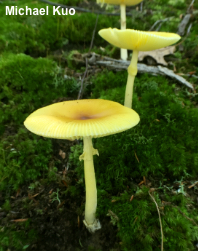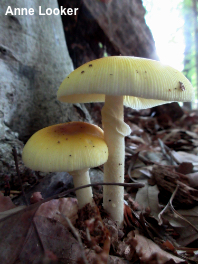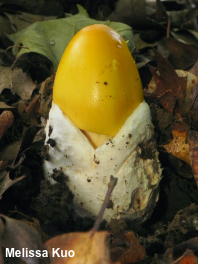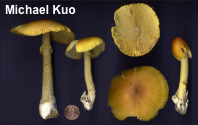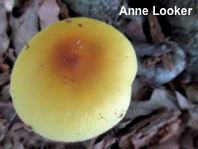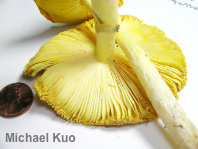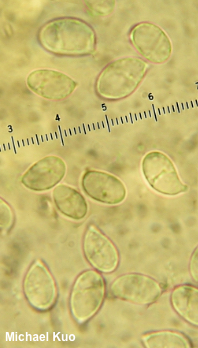| Major Groups > Gilled Mushrooms > Pale-Spored > Amanita > Yellow Caesar |

|
Amanita species 04: The Yellow Caesar [ Basidiomycota > Agaricales > Amanitaceae > Amanita . . . ] by Michael Kuo This beautiful mushroom, like Amanita jacksonii, is a North American version of the well-known European species Amanita caesarea. It is distinguished by its yellow to yellowish bronze cap, which is often brownish in the center and is prominently lined–and its fairly small size; it maxes out at about 10 cm across, with a stem under 2 cm thick. Like other members of the caesarea species group, it has a white, sacklike volva, a ring on the upper stem. Amanita species 04 is associated with oaks and other hardwoods east of the Great Plains, from roughly Interstate 70 (a line from Kansas City to Washington, DC) northward. Though it is fairly easily recognized and has been recorded in eastern North America since the beginning of the 20th century, this species has not yet been officially described and published, according to Amanita expert Rodham Tulloss, who has given it a provisional name at his website. Amanita arkansana is very similar, but is a much larger mushroom (the cap often reaches 15 cm and the stem is often 2 cm thick) with a slightly more orange cap when fresh; it can also be separated by its spores, which are on average a bit smaller, and its range, from roughly Interstate 70 southward. There is overlap in the overall dimensions, spore size, and distribution of the two species, but "average" collections are fairly easily separated. In my experience the color of the gills or ring in the two species (putatively more white in Amanita arkansana according to some sources) is variable and does not serve as a particularly useful identification character. Thanks to Anne Looker for documenting, collecting, and preserving Amanita species 04 for study; her collection is deposited in The Herbarium of Michael Kuo. Description: Ecology: Mycorrhizal with oaks, beech, and possibly with hickories; summer; distributed east of the Great Plains from roughly I-70 northward. The illustrated and described collections are from Illinois, Indiana, and Maryland. Cap: 4–9 cm across; oval at first, expanding to convex and, later, planoconvex; bald; sticky when fresh, but soon dry; yellow to bronze-yellow, becoming yellow-brown over the center; typically without warts or patches; the margin grooved for several centimeters. Gills: Free from the stem or slightly attached to it; yellow to pale yellow or white; close or crowded; not discoloring; short-gills present. Stem: 8–12 cm long; 1–1.5 cm thick; tapering slightly to apex; base even, or with a slight bulb; dry; bald or finely silky; yellow to whitish; with a white to pale yellow, skirtlike ring and a thick, white, sacklike volva. Flesh: White; hollowing in stem; not staining on exposure. Odor: Not distinctive. Chemical Reactions: KOH negative on cap surface. Spore Print: White. Microscopic Features: Spores 9–12 x 5–7 µm; ellipsoid to slightly amygdaliform; smooth; hyaline in KOH; inamyloid. Basidia 4-sterigmate. Hymenial cystidia not found. Subhymenium cellular. Pileipellis an ixocutis of elements 2–5 µm wide, hyaline to yellowish in KOH. REFERENCES: Herb. Kuo 07230301, 07051401, 07161901. This site contains no information about the edibility or toxicity of mushrooms. |
© MushroomExpert.Com |
|
Cite this page as: Kuo, M. (2020, February). Amanita species 04: The yellow Caesar. Retrieved from the MushroomExpert.Com Web site: http://www.mushroomexpert.com/amanita_sp_04.html |
